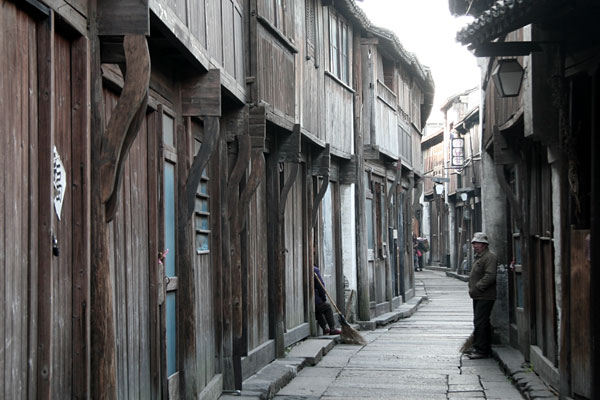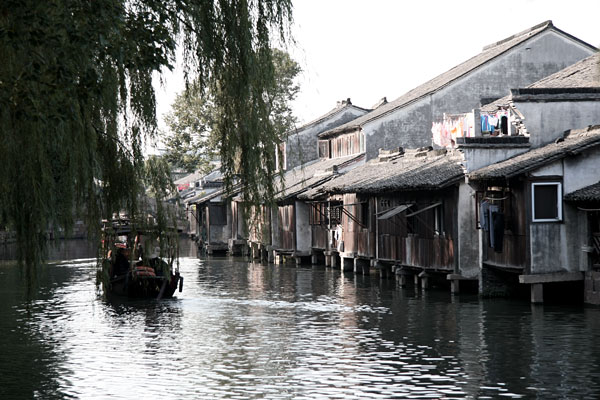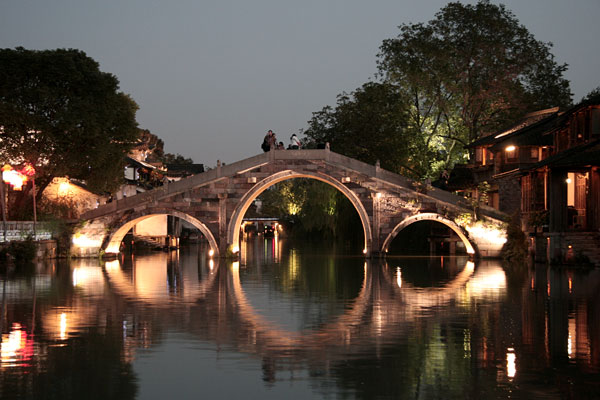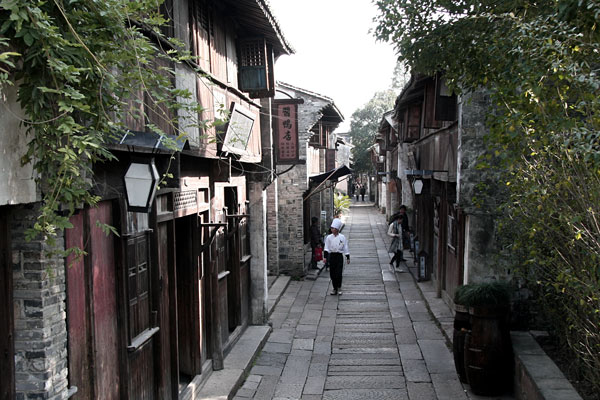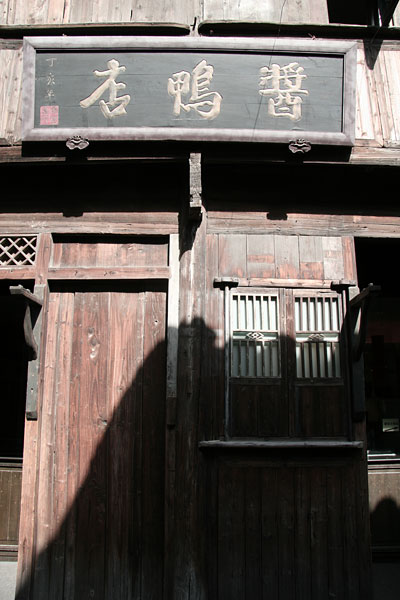
Wherever we travel, part of our ritual involves seeking a stay in the region's traditional dwellings, characteristic to the local area and nowhere else. In Kyoto it came in the form of a dilapidated wooden Machiya townhouse near Nijo Castle, and in Beijing it was a Siheyuan courtyard house on an inner-city Hutong alley. This time in the waterfront towns of Eastern China we wanted two different experiences -- a couple nights a in genuine Qing Dynasty mansion, and at least one in a traditional rowhouse by the water's edge, overlooking the passing boats along the 1000-year-old canal. Our first wish would have to wait until Xitang and Tongli, but our second wish would be satisfied in Wuzhen West.
Hotel Review: WUZHEN GUESTHOUSE (Wuzhen)
Address: Multiple houses on Xizha Dajie, Wuzhen Xizha Scenic Area
Price: Our room cost RMB 570, though double rooms started at RMB 340
Website/Map: See Official Site
First I have to warn that this was the second most expensive stay of our 17-day trip, next to the murderous hotel pricing at the peak of the Huangshan Mountain. But note what's already included in the price -- a free second day of sightseeing inside Wuzhen West before checking out. After all, nobody checked for tickets once we're in. Our Plan B would be to stay outside the paid-access zones and buy individual tickets for Wuzhen East and for Wuzhen West on two separate days, but we opted for the simpler plan and the better room, for a slightly higher overall price.

This was what we paid RMB 570 (CAD$90) for -- our own private balcony overhanging the ancient waters of the canal. Prices in the Guesthouses of Wuzhen West were standardized as follows at the time of our visit: RMB 340 for double rooms, RMB 470 for double rooms with a canal-facing window, and RMB 570 for these balcony rooms in limited quantities. In fact the quantities are so limited that booking sites such as CTrip and ELong do NOT offer these rooms. There are currently two known ways of booking these limited-quantity rooms: i) booking through Wuzhen's Chinese Site with either a Chinese-bank-issued credit card or a Chinese bank account, or ii) phoning Wuzhen's call centre at +86-573-8873-1088, which was how I ended up booking our room, with the advantage of not having to pre-pay until our arrival. If this is what you want, ask for a "1.5-metre Balcony Room for the Wuzhen Guesthouse" when you make the call.

The room itself was as comfy as you would expect of a B&B guestroom in Europe or in North America, with a soft mattress (which is somewhat rare in China), a western-style washroom and shower, and included excellent services such as the free luggage transfer by boat between Wuzhen West's main entrance lobby and the guesthouse. On the second day we were able to check out and hand our backpacks to the host, finish our sightseeing in town then take the free boat to the main entrance to meet our baggage.

The best part was our day was a few quiet hours of leaning against these balustrades, breathing the air of ancient Jiangnan and watching the flat-bottom boats glide past our balcony in the direction of the Beijing-Hangzhou Grand Canal. It was this particular moment, and not our earlier time in Shanghai or Hangzhou, when I finally felt immersed into Eastern China.

It was a pleasure waking up to a generously portioned home-made breakfast of regional fare, including Stir-Fried Niangao rice cakes, a local version of glutinous rice pudding known as Dingshenggao, and the ubiquitous Youtiao donut. Eggs were made-to-order: one sunny side up, and one steamed salt-pickled duck egg for the two of us to share. The rice porridge was all-you-can-eat, and came with a myriad of pickled vegetables and peanuts as usual.
This was an easily recommendable hotel, especially for first-time visitors to China who don't want to risk too much culture shock. While room prices are on the medium-high end, one has to factor in the first-world amenities, cleanliness and service, in addition to an extra day of sightseeing inside Wuzhen West. While our next night in Xitang cost only RMB 150 in comparison, we had no regrets spending RMB 570 here at Wuzhen Guesthouse.
RESTAURANT REVIEWS
While in Wuzhen we made our pilgrimage to a locally acclaimed hole-in-the-wall eatery, hidden in a side alley in the non-touristy part of town.
In fact the applauds from Chinese gourmands were so numerous and fervent that the existence of this eatery was partially why I looked forward to Wuzhen so much. As it turned out, the locals knew their stuff, and this meal turned out to be one of the most memorable of our 17-day trip.
This is likely the first ever English review of this eatery -- I searched everywhere before our trip but couldn't find any guidance in English. I hope this review will help more fellow travelers locate this authentic little gem.
Food Review: XIANGXIANG FANDIAN (Wuzhen)
Address: Guanhou Jie 40, Wuzhen
Hours: 11:00 – 21:00 (unofficial; based on observation)
Website/Map: Official Site (in Chinese)
Directions: Start from the Open-air Opera Stage just outside the paid-access zone of Wuzhen East. Walk north along the north-south street for one block and turn right onto Guanhou Jie. Xiangxiang is a little down the street on the right hand side.

I would never have found this decrepit shack of a restaurant without going out of our way to search for it. And even if we somehow came across this place by chance, I would never have dared to venture in without having previously seen recommendations on the Chinese side of the Internet. You can't ask for a more authentic mom-and-pop joint -- this one is sandwiched between a vacant closed-down store and an 8 Yuan barber shop.

What's the magic ingredient here that has all the local reviewers raving? Simmering underneath that mesh food cover at the storefront was the pride of Wuzhen, the local recipe of Red Braised Lamb (Hongshao Yangrou) made from a highly prized breed of local sheep, the salt-fed, marshland-raised Hu-Yang sheep. Yes, this is the Chinese equivalence of Agneau de Pre-Sale.
If you're wondering just how long this giant vat of lamb had been simmering for, you'd be wiser not to ask. Much like the soup-marinade in Hong Kong's Chu-Hau Beef Tripe or Xi'an's Lamb Pao Mo, the glittery dark sauce at the best street-side eateries are often as old as the shops themselves, never thrown away but only incrementally enhanced with the daily addition of fresh meat and herbs. No local gourmand would disagree: the older the sauce, the deeper the flavor.

Walk into the shop and you immerse even deeper into authentic rural China -- tables stashed sideways, trays of drying dishes stacked waist-high, and every patron quietly chowing down on the one dish that made this place famous. On first glance everything looks just like any other mom-and-pop eatery anywhere, except for photos of visits from Chinese TV celebrities and politicians plastering the walls.

Upon sitting down we spotted the first sign of top quality ingredients -- this intensely yellow, deeply flavored tea made from local Baby Chrysanthemums was actually the best and the strongest Chrysanthemum Tea either my wife or I had ever tasted. As far as I knew Baby Chrysanthemums, or Taiju as they're locally known, weren't cheap to begin with and required a more generous amount than most tea leaves to make a pot of the same size. This was a good sign: no matter how messy the shop might appear, the food was definitely for real.

Arriving first as a cold appetizer was a plate of Indian Aster with Dried Tofu (Xianggan Malan), a local favorite in the Lower Yangtze Delta. I thought it was the right dish to kick off the meal, as the slightly bitter Indian Aster is considered a "Yin" ingredient in Traditional Chinese Medicine terms and the perfect balance against the "Yang" ingredient in lamb and mutton. The taste was much like any Malantou I've had anywhere, with the same distinct, leafy flavor similar to Dandelion Greens in Mediterranean Cuisine. This would be my palate cleanser between mouthfuls of rich-tasting lamb.

Next up was an excellent dish which my wife called the best taro she had ever tasted. This Deep-Fried Taro with Scallion-Oil (Congyou Yunai) wasn't even on the written menu -- it was just recommended to us by the owner's wife as we visited during the taro season in early November. The sweetness of baby taro roots and the refreshing simplicity of scallions were combined into an addictively crunchy snack dish. You can see why local school kids aren't so hooked on French Fries like their Western counterparts, if they've got something this good waiting for them in their mom's kitchen.

Finally it was the one dish we'd been waiting for: Wuzhen's famous Red Braised Lamb. I'm sure this was what the Shanghainese had in mind when they coined the term Nongyou Chijiang, or literally Rich and Oily with Red Sauces. Inside the mysterious dark concoction was the perfect balance of Zhejiang's famous yellow wine and red cane sugar, dark soy sauce, a hint of hot chili pepper, and whatever secret ingredient the owner determined to best pair with his slow-braised Hu-Yang lamb.
I must first point out -- my wife generally does NOT eat lamb, shunning the meat for its strong gamey taste. But Wuzhen was so far from Canada that we might never return, and this hole-in-the-wall eatery was surrounded by such a mystique that she was curious enough to want to try it. However should it turn out overpoweringly gamey, I was prepared to order her something mild like a steamed fish.
She ended up finishing HALF of the lamb. Both of us agreed that it was the best lamb ever ... and this wasn't so long after I previously had my best lamb at Beijing's Hongyuan Hotpot. The flavor of that dark sauce was incredibly deep and complex from years upon years of compounding the essence of lamb bones and sinew, and the flesh was simply fall-off-the-bone tender. And the gameyness ... what gameyness? It was just like top quality beef only with a sweeter and more concentrated meaty flavor, and this was coming from my wife.
So our favorite memory of Wuzhen actually wasn't the idyllic boats cruising down the picturesque canals, but of a greasy, crumbling corner eatery serving up an impossibly great dish despite its unappealing appearance. Three months since leaving Wuzhen and I still can't find any motivation for cooking any lamb dishes. And how could I with my inferior cooking skills, after tasting the ultimate benchmark for how lamb is supposed to taste like?
Bill for Two Persons
| Dried Tofu with Indian Aster | RMB 15 |
| Deep-Fried Taro with Scallion-Oil | RMB 18 |
| Red Braised Lamb | RMB 45 |
| Rice x 2 | RMB 2 |
| TOTAL | RMB 80 (CAD$12.7) |
That was my top restaurant recommendation for Wuzhen, particularly if you're visiting or staying at Wuzhen East. If you're staying on the Wuzhen West side however, we did come across a couple of places worth trying out.
Food Review: XIAOMAZI LUOBOSIBING (Wuzhen)
Address: Xizha Dajie, Wuzhen
Hours: 09:00 – 21:00 (unofficial; based on observation)
Website/Map: N/A
Directions: Go inside the paid-access area of Wuzhen West. Walk along the main street (Xizha Dajie) and locate Guesthouse 29 on the left side. This little stand is almost right next to it.

This is not a restaurant, but an informal street-food stand inside the paid-access area of Wuzhen West. Note that all prices inside Wuzhen West are centrally fixed, meaning that food prices can get relatively expensive. The distinction of a great tasting, relatively filling and cheap snack makes this place automatic recommendable from me, especially if you're planning to last until exiting the over-priced Wuzhen West for that proper dinner.

The stand sells one and only one item -- the Luobosi Bing, or Deep-Fried Shredded Radish Patty. White Daikon radishes are freshly shredded in house, seasoned and pressed into an oval shape similar to a McDonald's hash brown, then deep fried to an alluring golden brown in front of your eyes. Expect line-ups starting from mid-morning and lasting till dinner time, as every visitor to Wuzhen West gets tempted by the alluring aroma from its deep-fryer, carried down the street for at least half a block.

While it's certainly not the healthiest of snacks, few could resist this greasy but filling bite of crispy and savory radish. The price of RMB 5 is a relative bargain, considering that the next cheapest fare is probably a bowl of Noodles with Lamb for RMB 25. For us this was the perfect light snack, before checking out and embarking towards the next ancient town on our route.
Bill for Two Persons
| Deep-Fried Shredded Radish Patty | RMB 5 |
Few options exist when it comes to cheap(er) options for sit-down dinners inside Wuzhen West, where food prices are all centrally fixed. There is the Hu-Yang Noodle House, where a simple bowl of Noodles with Lamb cost around RMB 25. There are also the different Guesthouses along the main street, most of which offer a menu of regional dishes from their own family kitchens. But then again prices for all standard dishes are centrally fixed, and we didn't come across any bargains.
Food Review: JIN'AN SIFANGCAI (Wuzhen)
Address: Xizha Dajie 239, Wuzhen
Hours: 12:00 – 21:00 (unofficial; based on observation)
Website/Map: N/A
Directions: Go inside the paid-access area of Wuzhen West. Walk along the main street (Xizha Dajie) and locate the Splendid Clubhouse on the right side. Jin'an Sifangcai is on the left, across from the clubhouse.

We followed recommendations from a bunch of Chinese travelers and ended up at Jin'an Sifangcai ... which was in fact NOT a Sifangcai (ie. private clubhouse) despite its name. This was the restaurant of the Splendid Clubhouse hotel, occupying a stretch of the canal shoreline beside one of the town's quaint stone bridges. The place probably has a good reputation among domestic tourists, as it was popular enough that we had to wait 15 minutes for a dinner table on a weeknight in the off-season.

Comfort food seemed to be the main theme here -- forget convoluted restaurant inventions like Eight-Treasure Stuffed Duck and think simple home-cooking that you may find in a local mom's kitchen. Our order of Grandma's Tossed Cabbages came drizzled with oil and soy sauce, uncomplicated flavors that has worked well over the past couple of millennia.

This Simmered Young Rooster with Hairy Taro (Mao Yunai Du Xiaogongji) was our second taro dish of the day, after the excellent deep-fried version at Xiangxiang earlier for lunch. Again the combination was simple and homey, though I have to say a little bland and unremarkable.
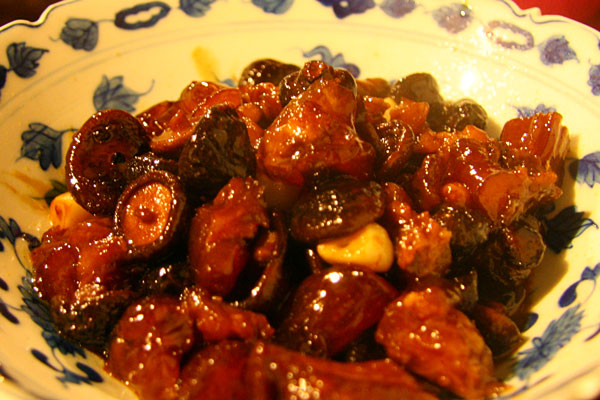
The best dish of the meal was probably this Braised Beef Tendons with Wild Shiitake Mushrooms (Yexianggu Shaoniujin). The tendons had become deliciously soft and gelatinous after hours of slow-simmering, and the baby Shiitake did give off that wild, woody flavor found only in the non-farm produced variety. While it may look glittering and oily from the picture, it actually wasn't too heavy considering that we were already prepared for our next dish.

We ordered a tub of Mixed Rice with LARD. Yes, as in refined pork fat, which has become a rare ingredient these days in metropolitan China. Though it may sound unhealthy, the fat was only lightly drizzled and mixed into the rice, which in effect prevented the individual grains from clumping together just like fried rice. The flavor of lard wasn't as notable as I thought, but then everything else was probably cooked in some lard already.
This place wasn't bad as a restaurant overall -- it just paled in comparison to the amazing food at Xiangxiang we had earlier that day for nearly half its price. But this was for a four-course dinner inside the posh resort of Wuzhen West, in a much cleaner and more charming restaurant overlooking the romantic canal at nightfall. These are two completely different sets of clientele I guess, aside from curious foodies like us.
Bill for Two Persons
| Simmered Young Rooster with Hairy Taro | RMB 45 |
| Braised Beef Tendons with Wild Shiitake Mushrooms | RMB 58 |
| Grandma's Hand-Tossed Cabbages | RMB 22 |
| Mixed Rice with Lard | RMB 22 |
| TOTAL | RMB 147 (CAD$23.3) |
















